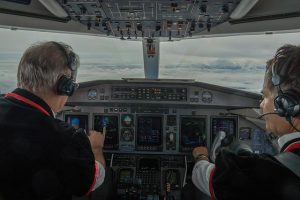
Airplane cockpits are equipped with a variety of notification lights, some of which are designed to warn pilots and copilots about potential hazards. Known as warning lights, they play an important role in flight safety.
What Are Warning Lights?
Warning lights are notification lights inside of airplane cockpits that illuminate automatically in response to a potential hazard. They work in conjunction with a master system.
A master system is a centralized computer that monitors all other systems on an airplane. During flight, the master system will monitor hydraulic pressure, cabin pressure, stall speed, engine performance and more. If there’s a problem with one of these systems, the master system will illuminate one or more warning lights. The pilot and copilot can then take the necessary action to correct the problem.
Red Lights
Warning lights feature different colors. Red-colored warning lights indicate a serious problem that requires immediate attention. If there’s a serious problem with the airplane that poses a safety hazard, warning lights inside of the cockpit will flash red. Pilots and co-pilots shouldn’t ignore red-colored warning lights. Of all the different warning lights, red is the most severe. Red-colored warning lights require immediate attention.
Amber Lights
Amber-colored warning lights indicate a moderate problem that requires timely, though not necessarily immediate, attention. Pilots and co-pilots should still correct the problem. Amber-colored warning lights, however, are a step down from their red-colored counterparts in terms of severity. They indicate a moderate problem with the airplane.
Blue Lights
In addition to red and amber, there are blue-colored warning lights. Blue-colored warning lights are typically used for informational purposes. They don’t indicate a problem or safety hazard. Rather, blue warning lights are designed to notify pilots and co-pilots when other systems are working.
In Conclusion
Problems can occur after airplanes take off and achieve flight. Fortunately, airplanes are now equipped with a master system that monitors the various other systems for problems. If the master system detects a problem, it will trigger one or more warning lights. Warning lights are colored red, amber and blue depending on their severity.
Severe problems that require immediate attention will trigger red-colored warning lights. Less-severe problems, conversely, may trigger blue-colored warning lights. Regardless, warning lights are designed to help pilots and co-pilots correct problems that could otherwise pose a threat to their safety and the safety of their passengers.



